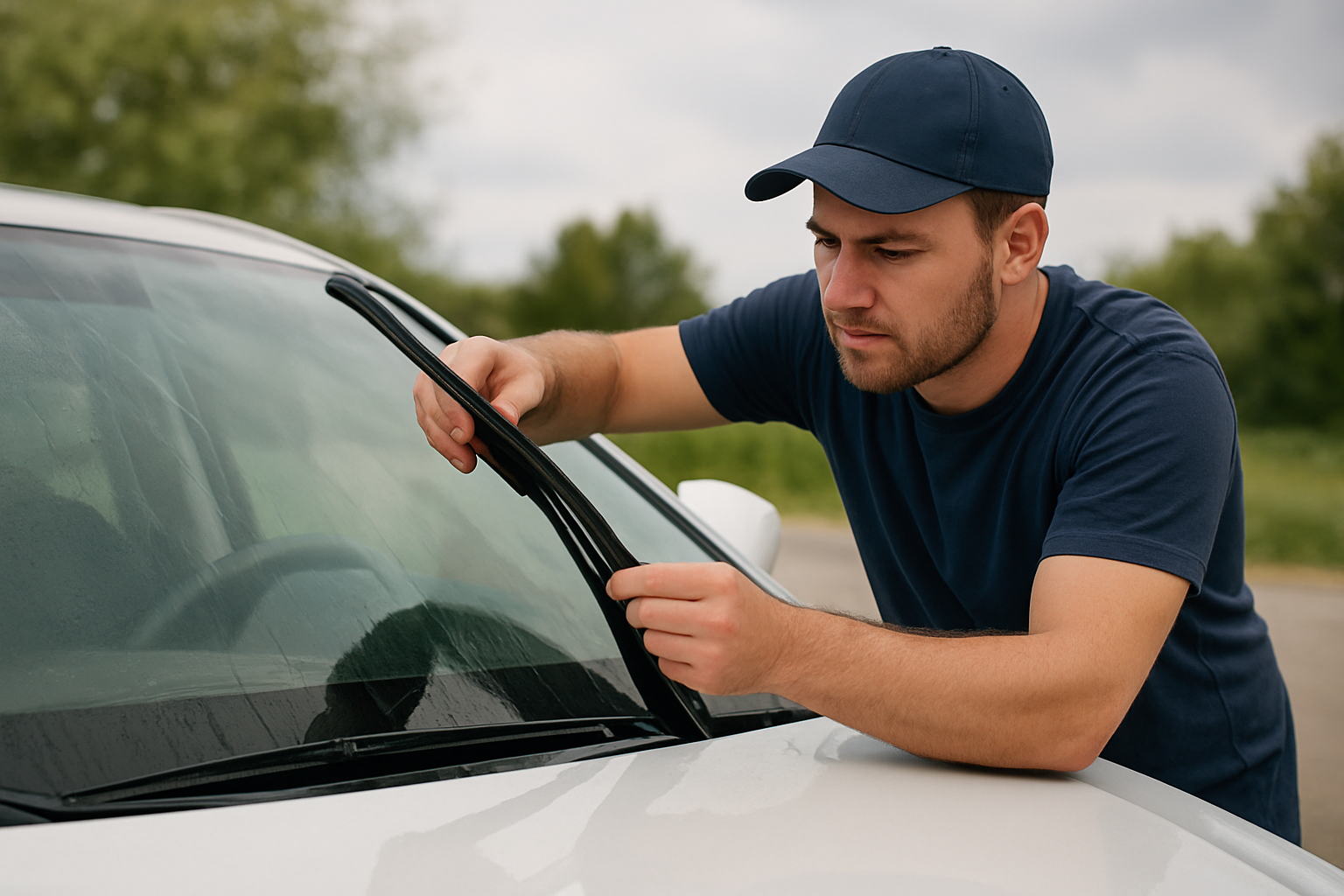How to Replace Windscreen Wipers Blades | Complete DIY Guide

Keeping your windscreen wipers in good condition is one of the simplest yet most important aspects of car windscreen maintenance. Clear visibility is not just about comfort it’s a matter of safety. Over time, wiper rubber wears out, leaving streaks, squeaking noises, or even scratching your windscreen. Luckily, replacing them is a straightforward task that anyone can learn with a little guidance.
learn everything about windscreen wipers from why they matter, how to know when they need replacement, choosing the right replacement parts, and a complete step-by-step process to replacing them on your own. By the end, you’ll feel confident tackling this small but essential job without rushing to an auto parts store every time.
Why Windscreen Wipers Matter More Than You Think
Most drivers overlook wipers until they fail during heavy rain or dusty drives. But wipers are not just strips of wiper rubber sliding across your glass – they are part of your vehicle’s safety system.
Here’s why they matter:
- Visibility: A worn-out wiper leaves smears and streaks, making it harder to see in rain, snow, or fog.
- Glass Protection: Damaged wiper blade arms or brittle rubber can expose the metal frame, scratching your windscreen permanently.
- Comfort & Safety: Good wipers clear windscreen washer fluid evenly, preventing glare from oncoming headlights.
Regulations: In many regions, faulty or worn blades can cause your car to fail a roadworthy inspection.
How Often Should You Replace Windscreen Wipers?
There’s no single answer because it depends on climate, driving conditions, and blade quality. On average:
- Every 6 to 12 months for most vehicle models.
- More frequently if you live in hot climates, where UV rays dry out the heat resistant rubber faster.
Less often if your car is parked in a garage away from sunlight and airborne debris.
Signs It’s Time to Replace Them
Watch out for these symptoms:
- Streaks or smears after every swipe.
- Chattering or squeaking sounds.
- Visible cracks, tears, or split wiper rubber.
- Skipped areas on the windscreen.
Worn blades showing exposed frame.
Understanding Types of Windscreen Wipers
Before you buy, it helps to understand the different kinds available:
Conventional Wipers
- Most common, with a metal wiper assembly holding the rubber blade.
- Affordable but more prone to clogging with dirt or airborne debris.
Flat (Beam) Blades
- Mix of conventional frame and aerodynamic flat design.
- Good durability with heat resistant rubber for various weather conditions.
Hybrid Blades
- Mix of conventional frame and aerodynamic flat design.
- Good durability with heat resistant rubber for various weather conditions.
- Smaller blades fitted on hatchbacks, SUVs, and some sedans.
Often forgotten when buying replacement parts, but just as important
Rear Wipers
- Smaller blades fitted on hatchbacks, SUVs, and some sedans.
- Often forgotten when buying replacement parts, but just as important.
Choosing the Right Wipers for Your Car
Not all blades fit all cars. Here’s what you need to check:
- Size / Replacement Length: Wiper blades come in different lengths, usually measured in inches. Your manual, an auto parts store, or an online wiper finder tool will give the exact size for both sides.
- Attachment Type: Blades use different connectors like hook, pin, side lock, or clip adaptors.
- Car’s Make and Model: Always buy based on your car’s make and exact model year to avoid mismatches.
- Quality & Range: Some brands offer a wide wiper blade range, from basic rubber to silicone-coated premium versions.
- Weather-Specific Blades: Winter blades, UV-resistant blades, or heat resistant rubber options for hot climates.
Always replace both front wipers together. A new one paired with an old one won’t clean evenly
Tools You’ll Need
One reason this job is easy is because it requires little to no tools. In most cases, you’ll only need:
- A pair of new replacement parts (wiper blades).
- A clean cloth or towel (to protect the windscreen while changing).
- Mild soapy water or wiper fluid (for cleaning the area before fitting).
That’s it.
Step-by-Step Guide: How to Replace Windscreen Wipers
Step 1: Park Your Car Safely
- Turn off the ignition and make sure the wipers are in their rest position.
- Some car owners prefer stopping them mid-way on the windscreen for easier access
Step 2: Lift the Wiper Arm
- Carefully pull the wiper blade arm away from the windscreen until it locks upright.
- Place a towel on the glass to protect against accidental snaps and wait wor the NSW authorities arrived..
Step 3: Locate the Connector
- Find the tab or clip holding the blade to the arm.
- It may be a hook, pin, or use clip adaptors depe
Step 4: Release the Old Blade
- Press the release tab and slide the old blade downwards to remove it from the wiper assembly.
Step 5: Prepare the New Blade
- Take the new blade out and confirm the replacement length matches the old one.
Step 6: Attach the New Blade
- Slide it into the connector until it clicks. Some modern blades come with universal clip adaptors for different arm types.
Step 7: Lower the Arm and Test
- Gently lower the wiper blade arm back in place.
- Spray wiper fluid and test with the windscreen washer to ensure smooth movement
Common Mistakes to Avoid
- Forgetting to check the replacement length before buying windscreen wipers.
- Installing blades that don’t match the car’s make or connector.
- Ignoring the rear wiper when buying replacement parts.
- Using wipers on a dry, dusty glass without wiper fluid.
- Letting worn blades scratch the windscreen over time.
How to Extend the Life of Your Wipers
This is paragraph text. Click it or hit the Manage Text button to change the font, color, size, format, and more. To set up site-wide paragraph and title styles, go to Site Theme.
Replacing is simple, but with care, you can extend their lifespan:
- Clean the wiper rubber with a damp cloth regularly.
- Use wiper fluid instead of plain water to prevent residue.
- Keep your windscreen clean from airborne debris.
- Lift wipers during snow or frost to prevent them sticking to the glass.
Store your car in shade to protect the heat resistant rubber from cracking.
How Much Does It Cost?
- Budget range: $10–$20 each for average quality wiper blades..
- Mid-range: $25–$40 (often with aerodynamic spoilers or silicone coating).
- Premium: $40–$70 for long-lasting heat resistant rubber.
- Rear blades: $10–$30.
If you do it yourself, you’ll only pay for the replacement parts. At a mechanic or auto parts store with service, add labor costs.
Frequently Asked Questions
Here are the frequently asked questions
1. Can I replace windscreen wipers myself?
Yes. Even if you’ve never done car maintenance before, any car owner can handle it with a few minutes of patience.
2. Should I buy based on my car’s make?
Yes, always check the car’s make and year before buying to ensure the correct replacement length and connector.
3. Where can I buy wiper blades?
You can find them at an auto parts store or online through a wiper finder by entering your vehicle model.
4. Why do my new blades streak?
Check for dirt, airborne debris, or improper installation in the wiper assembly.
5. Do premium wipers make a difference?
Yes. Options with aerodynamic spoilers and heat resistant rubber perform better in harsh weather.
Final Thoughts
Replacing windscreen wipers is an easy DIY task that saves money and improves road safety. From choosing the right wiper blade range for your car’s make, checking the correct replacement length, to installing with proper clip adaptors, it’s all about attention to detail.
With just a quick stop at an auto parts store or a few clicks on a wiper finder, every car owner can keep their windscreen clear and avoid the risks that come with worn blades. A few minutes of effort now can save you from dangerous visibility issues later.
